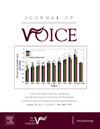Phonation-induced Upper Esophageal Sphincter Contraction Caused by Different Phonation Types
IF 2.5
4区 医学
Q1 AUDIOLOGY & SPEECH-LANGUAGE PATHOLOGY
引用次数: 0
Abstract
Introduction
The upper esophageal sphincter (UES) has been reported to show activity during phonation. As it is still unknown whether the phonation-induced UES contraction represents a reflex or a simultaneous activation phenomenon, i.e. co-innervation, this study aims to investigate and characterize the phonation-induced contraction of the UES in healthy individuals by analyzing the influence of various phonation tasks on pressure parameters of the UES.
Methods
Twenty-five healthy volunteers produced the German neutral vowel [ə] in five different phonation tasks (modal voice, whispering, voiceless speech, creaky voice, and whispery voice). Simultaneously, they underwent high resolution manometry and electroglottography for measurement of pressure parameters in the region of the UES and latencies between larynx and UES activation.
Results
During all types of phonation, the maximum pressures of the UES increased significantly (maximum pressure increases of 72%-132%). With regard to mean pressures this was valid for modal voice and whispering (mean pressure increases of 20%-25%). Differences concerning total pressure changes reached statistical significance when comparing whispering and voiceless speech as well as whispery voice. However, differences concerning the total pressure change between modal voices on the one hand and voiceless speech and whispery voice on the other hand turned out to be small. The averaged time delay between larynx and UES activation ranged from approximately -15 ms (whispery voice) to +15 ms (whispering).
Conclusion
A phonation induced pressure increase of the UES was confirmed in this study and did exist for different types of phonation. The extent of total pressure changes in the UES increases in relation with laryngeal muscle activity necessary for the phonation type. Next to varying effects of different types of phonation on UES activation, very short latencies indicate that a phonation induced contraction of the UES exists most likely due to co-innervation of UES and laryngeal muscles by the vagus nerve.
不同发音类型导致的发音诱发上食道括约肌收缩。
介绍:据报道,食管上括约肌(UES)在发音时会出现活动。本研究旨在通过分析各种发音任务对食管上括约肌压力参数的影响,研究和描述健康人食管上括约肌在发音时的收缩:方法:25 名健康志愿者在五种不同的发音任务(模态语音、耳语、无声语音、嘎吱嘎吱声和耳语)中发出德语中性元音 [ə]。同时,他们还接受了高分辨率测压和声门电图检查,以测量声门区域的压力参数以及喉和声门激活之间的潜伏期:在所有类型的发音过程中,声门上腭的最大压力都显著增加(最大压力增加了72%-132%)。在平均压力方面,模态声和耳语也是如此(平均压力增加了 20%-25%)。在比较耳语和无声语音以及耳语时,总压力变化的差异达到了统计学意义上的显著性。然而,模态语音与无声语音和耳语语音之间的总压力变化差异很小。喉部和上声道激活之间的平均时间延迟从大约 -15 毫秒(耳语)到 +15 毫秒(耳语)不等:结论:本研究证实,不同类型的发声确实存在发声诱导的声门上腭压力增加。发音类型所需的喉部肌肉活动会增加上颚总压力变化的程度。除了不同类型的发音对上腭肌激活的不同影响外,极短的潜伏期也表明上腭肌存在由发音引起的收缩,这很可能是由于迷走神经对上腭肌和喉部肌肉的共同支配。
本文章由计算机程序翻译,如有差异,请以英文原文为准。
求助全文
约1分钟内获得全文
求助全文
来源期刊

Journal of Voice
医学-耳鼻喉科学
CiteScore
4.00
自引率
13.60%
发文量
395
审稿时长
59 days
期刊介绍:
The Journal of Voice is widely regarded as the world''s premiere journal for voice medicine and research. This peer-reviewed publication is listed in Index Medicus and is indexed by the Institute for Scientific Information. The journal contains articles written by experts throughout the world on all topics in voice sciences, voice medicine and surgery, and speech-language pathologists'' management of voice-related problems. The journal includes clinical articles, clinical research, and laboratory research. Members of the Foundation receive the journal as a benefit of membership.
 求助内容:
求助内容: 应助结果提醒方式:
应助结果提醒方式:


